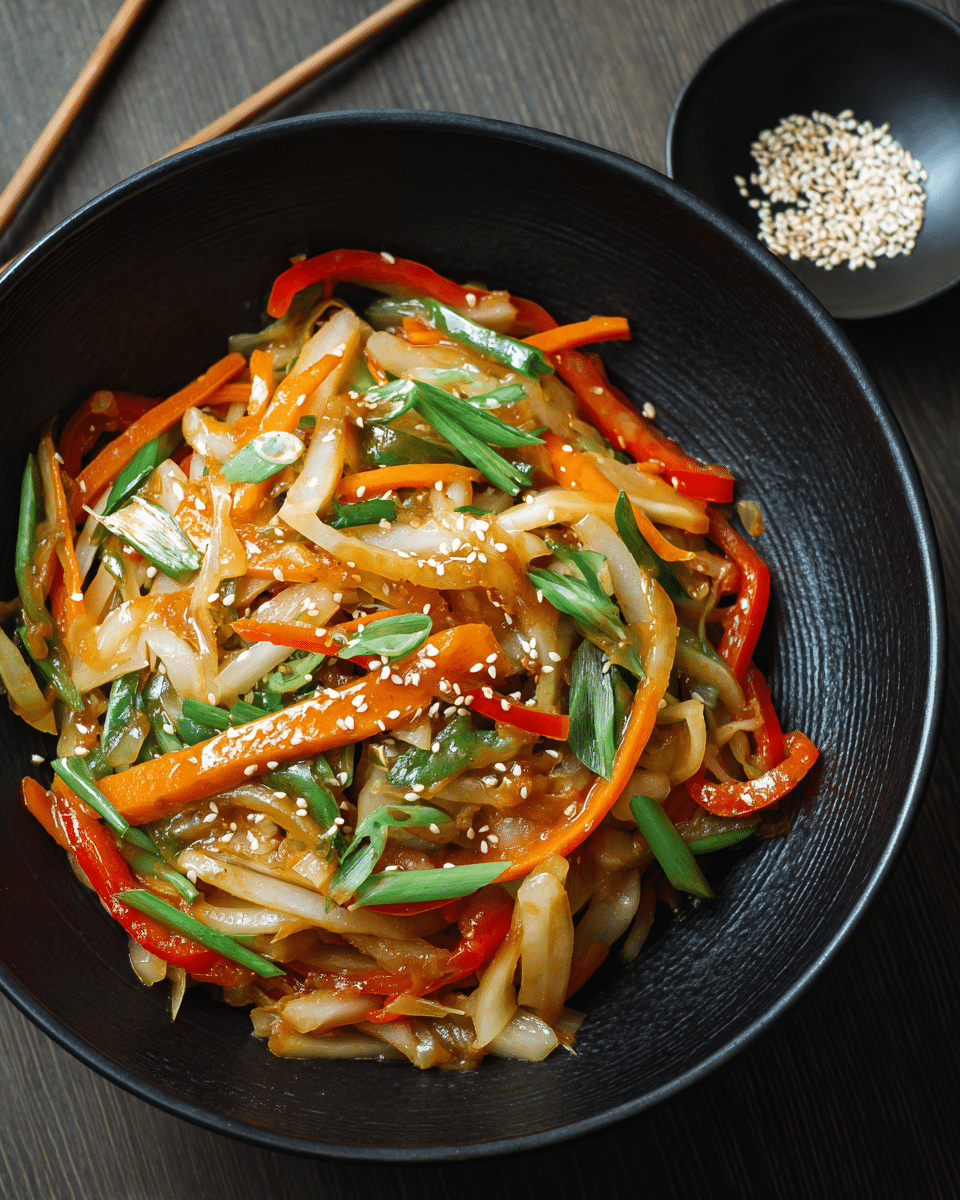This Kohlrabi Stir-Fry is a speedy and satisfying dinner, perfect for busy weeknights. Packed with crunchy vegetables, aromatic garlic and ginger, and a savory soy-based sauce, it’s a delicious way to highlight the subtle sweetness and crunch of kohlrabi. Serve it on its own or over rice for a complete, nourishing meal.
FULL RECIPE
Ingredients
- 2 medium kohlrabi bulbs, peeled and julienned
- 1 large carrot, julienned
- 1 red bell pepper, sliced thin
- 2 tablespoons vegetable oil
- 2 garlic cloves, minced
- 1 teaspoon fresh ginger, minced
- 2 green onions, sliced
- 2 tablespoons soy sauce (or tamari for gluten-free)
- 1 tablespoon rice vinegar
- 1 teaspoon sesame oil
- 1 teaspoon honey or maple syrup (optional)
- Salt and pepper to taste
- Toasted sesame seeds, for garnish (optional)
Directions
- Heat vegetable oil in a large skillet or wok over medium-high heat.
- Add garlic and ginger; sauté for 30 seconds until fragrant.
- Add kohlrabi, carrot, and bell pepper. Stir-fry for 4–6 minutes, or until vegetables are just tender but still crisp.
- Stir in soy sauce, rice vinegar, sesame oil, and honey/maple syrup (if using). Toss to coat evenly.
- Cook for another 1–2 minutes to let the flavors meld.
- Season with salt and pepper to taste.
- Remove from heat. Garnish with green onions and sesame seeds if desired. Serve warm.
Nutrition Facts
- Calories: 130
- Protein: 2g
- Fat: 8g
- Saturated Fat: 1g
- Carbohydrates: 13g
- Fiber: 3g
- Sugars: 6g
- Sodium: 490mg
Nutritional Benefits of Kohlrabi
Kohlrabi is a nutrient-dense vegetable that offers a range of health benefits, making it an excellent choice for a wholesome stir-fry. It is rich in vitamin C, which supports immune function and skin health, and contains a good amount of dietary fiber, aiding digestion and promoting a feeling of fullness. Kohlrabi also provides potassium, which helps regulate blood pressure, and antioxidants that combat oxidative stress. Including kohlrabi in your diet can contribute to overall wellness while keeping calorie intake low, making it suitable for weight management.
Why Stir-Fry?
Stir-frying is a quick and efficient cooking method that preserves the nutrients, texture, and vibrant colors of vegetables like kohlrabi. This technique uses high heat and minimal oil, allowing vegetables to cook evenly and retain their crunch. The rapid cooking time also helps lock in flavor and nutrients compared to longer cooking methods. Stir-frying is versatile and customizable, making it easy to incorporate a wide variety of ingredients for balanced meals with maximum taste and nutritional value.
Flavor Profile and Texture of Kohlrabi
Kohlrabi has a mild, slightly sweet, and peppery flavor, somewhat reminiscent of broccoli stems or cabbage hearts but with a crunchier texture. When stir-fried, it softens slightly but still maintains a satisfying crispness, adding a pleasant contrast to softer vegetables or proteins. This unique texture makes kohlrabi a versatile ingredient in stir-fries, as it absorbs sauces well without becoming mushy, providing a fresh and hearty bite.
Complementary Vegetables for Stir-Fry
While kohlrabi shines on its own, pairing it with complementary vegetables enhances the overall dish. Carrots bring natural sweetness and color, bell peppers add crunch and a slight tang, and green onions contribute a mild sharpness and freshness. You can also add snap peas, broccoli florets, or mushrooms to vary texture and flavor. Combining vegetables with different colors and nutrient profiles makes the stir-fry visually appealing and nutritionally balanced.
Health Benefits of the Stir-Fry Sauce Ingredients
The sauce used in a kohlrabi stir-fry typically contains soy sauce, ginger, garlic, sesame oil, and sometimes rice vinegar and a touch of sweetness like honey or maple syrup. Garlic and ginger are well-known for their anti-inflammatory and immune-boosting properties. Soy sauce provides umami flavor and some minerals, while sesame oil adds healthy fats that support heart health. The combination of these ingredients not only elevates the flavor but also adds functional health benefits to the dish.
Variations for Different Diets
This kohlrabi stir-fry can be easily adapted to fit various dietary preferences and restrictions. For a gluten-free version, use tamari or coconut aminos instead of regular soy sauce. To make it vegan, simply substitute honey with maple syrup or agave nectar. Adding tofu, tempeh, or seitan can boost the protein content for vegetarians and vegans. For a higher-protein, low-carb meal, serve the stir-fry over cauliflower rice or alongside grilled chicken or shrimp.
Serving Suggestions and Pairings
Kohlrabi stir-fry pairs well with a variety of staples. Serving it over steamed jasmine rice, brown rice, or quinoa provides a complete meal with carbohydrates and fiber. For a low-carb option, cauliflower rice or spiralized zucchini work well. This stir-fry can also be served alongside other Asian-inspired dishes such as dumplings, miso soup, or a fresh cucumber salad. Garnishing with toasted sesame seeds or chopped fresh herbs like cilantro can add an extra burst of flavor and texture.
Storage and Reheating Tips
Leftover kohlrabi stir-fry can be stored in an airtight container in the refrigerator for up to 3 days. To maintain the best texture when reheating, warm it gently in a skillet over medium heat rather than microwaving, which can sometimes make vegetables soggy. Adding a splash of water or a few drops of oil during reheating can help restore moisture. Avoid freezing this stir-fry as the texture of the vegetables may degrade significantly after thawing.
Seasonal Availability and Buying Tips
Kohlrabi is available year-round in many grocery stores but is freshest and most flavorful in late fall through early spring. When buying kohlrabi, look for firm bulbs without soft spots or cracks. The leaves (if attached) should be vibrant green and fresh-looking; these can also be cooked like kale or collard greens. Choosing smaller bulbs typically means sweeter and more tender flesh, ideal for stir-frying.
Environmental Impact and Sustainability
Incorporating kohlrabi into your diet supports sustainable eating practices. Kohlrabi is a hardy vegetable that grows quickly and requires fewer resources than many other crops, making it an eco-friendly choice. Its versatility reduces the need for multiple ingredients, simplifying meals and minimizing food waste. By embracing vegetables like kohlrabi, you contribute to a more sustainable food system that values seasonality and plant-based nutrition.
Cultural and Culinary Context
Kohlrabi is widely used in Central European and Asian cuisines but is still gaining popularity in many parts of the world. In Asian cooking, it’s often included in stir-fries and soups, appreciated for its crunchy texture and subtle flavor. Its growing presence in contemporary Western kitchens reflects a broader trend toward diverse, healthful vegetables that add both nutrition and excitement to everyday meals. Exploring recipes like kohlrabi stir-fry invites culinary creativity while connecting with traditional flavors.
Conclusion
Kohlrabi stir-fry is a simple, nutritious, and delicious dish that highlights the unique qualities of this underappreciated vegetable. Its crisp texture, mild flavor, and health benefits make it a perfect ingredient for quick weeknight meals. With endless possibilities for customization, from different vegetables and proteins to various sauces and serving styles, this stir-fry can easily become a staple in your cooking repertoire. Embracing kohlrabi not only enriches your diet but also supports sustainable and mindful eating habits.






